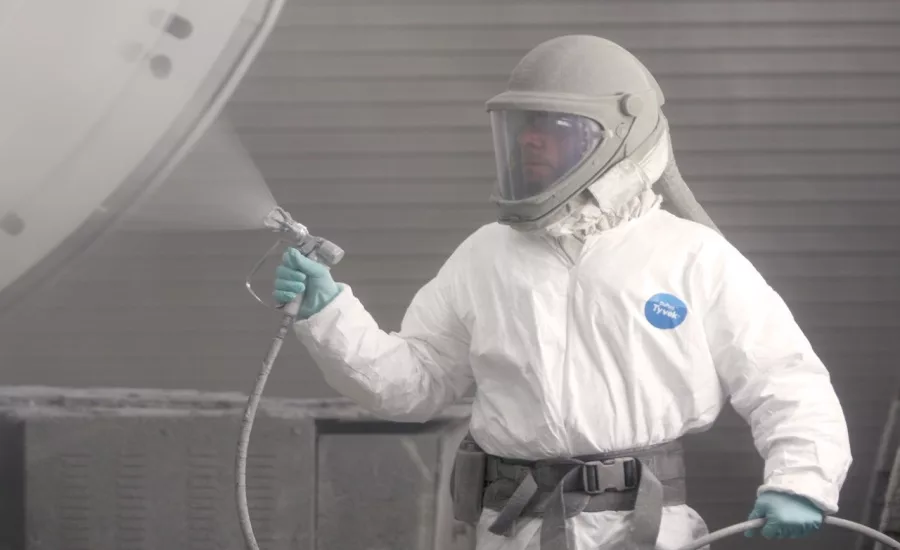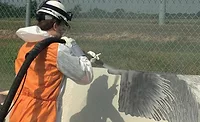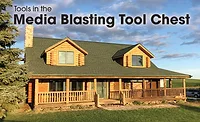Media Blasting: Finding the Balance Between Effective & Abrasive
Exploring vapor abrasive blasting and cleaning.

Mold remediation and restoring fire-damaged wood, concrete and brick using chemicals or steamers is not always the most cost-effective way to handle damaged areas. Media blasting can be so much more productive that it often makes economic sense to tackle restorations with traditional soda blasters or dry-ice blast equipment. These methods pale in comparison to media blasting in terms of productivity, but have the critical advantage of not damaging the underlying substrate.
Dry media blasting is often too dusty and sometimes too harsh for certain restoration and remediation applications. With dry media blasting out of the question, how does the restoration professional efficiently clean vast surface areas - schools, hospitals, government facilities, or any large commercial or industrial building - without compounding the damage?
First, let's take a look at the ways that may not work:
Organic media like ground corn cob and crushed nut shells are non-toxic and environmentally-friendly soft media that are good for stripping paint and contamination from wood substrates. They produce a low amount of dust, but can be less productive on large surface areas.
Dry ice is a go-to mold remediation method. The distinctive feature of dry ice is that it sublimates - passes from a solid to gaseous state - so it doesn’t leave spent abrasive for clean-up and removal. This is advantageous when working in attics or other tight spaces, especially if you are on your back, blasting overhead.
However, the fact that the media sublimates doesn’t mean that there no residue to clean up - whatever contaminant comes off the substrate still has to be swept up or vacuumed afterwards, so the amount of material to dispose of is reduced, but it doesn’t translate into significant savings of time or labor. In addition, using dry ice presents logistic challenges, especially on large projects: the media comes in large bins (500 lbs), suffers degrading productivity over time, and ultimately perishes.
Non-Organic media such as glass bead, fine crushed glass or fine garnet can be used in certain restoration applications. Glass bead is the softest media of the three mentioned above. All three media types can be used for efflorescence removal, cleaning of brick, stone or concrete, and different types of remediation. The ultimate factors in deciding what media to use are blast pressure at the nozzle and the type, properties and age of the substrate you are cleaning.
Baking soda is a blast media widely used for fire damage restoration. Its angular shape gives it good cutting power for such a soft media (2.5 Mohs) and it deodorizes surfaces on contact. Baking soda is biodegradable, but it kills vegetation, so it requires containment when blasting outdoors. Indoors, baking soda produces a heavy dust which can cause visibility problems in enclosed spaces and necessitates full containment, negative air pressure and ventilation, especially when dealing with mold, where it is critical that dislodged spores don’t circulate to unaffected areas.
These drawbacks can be negated to a degree by suppressing the dust and knocking down airborne mold and soot with water. This can be accomplished by using a water injection nozzle or halo ring which introduces water to the air stream. The disadvantage to this approach is that copious amounts of water are required for significant dust suppression, resulting in a slurry that needs to be contained and disposed of.
Now, moving on to what would likely work much better in areas where more damage, dust, and debris is a concern:
Vapor abrasive blasting or cleaning presents an alternative way for soda blasting without using as much water. Vapor abrasive blasting is very unique wet media blaster that uses the combination of media, air and minimal water to achieve maximum dust suppression while using little water compared to traditional wet media blasters.
With vapor abrasive blasting, media and water are stored in a pressurized pot, then pushed into the air stream. Media particles are encapsulated in a water jacket, but there is no excessive free water. When the particle pulverizes on impact, fine particles that would normally become airborne are sequestered in the water jacket and end up on the floor.
A key feature of vapor abrasive blasting is being able to use hard media at lower pressures. Moistened media carries more mass, and when it strikes a surface, high-velocity water undercuts contaminants, prying and peeling them off the substrate. More force is delivered on impact but over a wider area, minimizing surface profile while delivering high production rates.
With glass bead, crushed glass and fine garnet, blasting at 25-55 psi is suitable for cleaning wood, brick, restoring monuments and other finished concrete surfaces, soft stone, and aluminum. At 56-90 psi, vapor abrasive blasting is suitable for cleaning unfinished concrete or light surface prep.
The ultimate advantage of vapor abrasive blasting is versatility. Next-generation equipment like the new Graco Ecoquip 2 vapor media blaster (also called vapor abrasive) allows you to clean delicate substrates with soft abrasives at pressures as low as 25 psi, then switch to a coarse garnet or coal slag to blast heavily corroded and thickly coated steel to white metal blast cleaning at pressures up to 170 psi at the nozzle. No other tool enables you to meet such a wide range of restoration and surface preparation challenges.
Vapor abrasive blasting is the best way to efficiently clean large surface areas. When it is imperative to not damage the substrate, soft media like soda, dry ice and organic material are commonly used. The highest production rates are achieved with hard, fast cutting abrasives, which can be used effectively at low pressures without damaging the substrate with vapor media blast equipment, which provides the added benefit of suppressing dust, which in turn substantially reduces containment and clean-up costs.
Looking for a reprint of this article?
From high-res PDFs to custom plaques, order your copy today!






